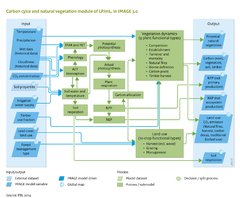Carbon cycle and natural vegetation/Data uncertainties limitations: Difference between revisions
Jump to navigation
Jump to search
No edit summary |
No edit summary |
||
| Line 1: | Line 1: | ||
{{ComponentDataUncertaintyAndLimitationsTemplate | {{ComponentDataUncertaintyAndLimitationsTemplate | ||
|Reference=IPCC, 2007a; Heyder et al., 2011; Schaphoff et al. (unpublished); Vetter et al., 2008; Bouwman et al., 2009; | |Reference=IPCC, 2007a; Heyder et al., 2011; Schaphoff et al. (unpublished); Vetter et al., 2008; Bouwman et al., 2009; | ||
|Description= | |Description=<h2>Data</h2> | ||
This model uses FAO’s [[Soil and vegetation characteristics|harmonised soil map]] of the world as its main external input, to provide information on soil texture and hydraulic properties. Climate input data come from the [[Atmospheric composition and climate]] model. To create an equilibrium of terrestrial carbon pools at the start of a simulation, a 700-year spin-up run is carried out. The carbon stocks and fluxes have been compared to IPCC estimates ([[IPCC, 2007a]]) and are well within the uncertainty range. The modelled distribution of plant functional types has been compared to other data sources (RefXXX). | This model uses FAO’s [[Soil and vegetation characteristics|harmonised soil map]] of the world as its main external input, to provide information on soil texture and hydraulic properties. Climate input data come from the [[Atmospheric composition and climate]] model. To create an equilibrium of terrestrial carbon pools at the start of a simulation, a 700-year spin-up run is carried out. The carbon stocks and fluxes have been compared to IPCC estimates ([[IPCC, 2007a]]) and are well within the uncertainty range. The modelled distribution of plant functional types has been compared to other data sources (RefXXX). | ||
==Uncertainties== | |||
Although the terrestrial biosphere plays an important role in the global carbon cycle, it is also subject to considerable uncertainty. Current carbon fluxes already are highly uncertain, as they cannot be observed directly, on a large scale, and vary strongly over time and space. Therefore, all available estimates on global carbon pools and fluxes are model-based estimates. For the future dynamics of the terrestrial carbon cycle, additional uncertainty arises from the involved physiological and ecological processes and interactions, which change rapidly under changing environmental conditions. Being a [[DGVM]], IMAGE-LPJmL is capable of simulating carbon dynamics under internally computed vegetation shifts that occur as a response to climate change, the impacts of land-use change, water availability and CO2 fertilisation ([[Heyder et al., 2011]]). The most uncertain parameters in future dynamics are the combined effect of temperature and precipitation change on soil respiration, and the effect of CO2 fertilisation. An uncertainty range for how the terrestrial biosphere may react to scenarios of climate change has been presented above. | Although the terrestrial biosphere plays an important role in the global carbon cycle, it is also subject to considerable uncertainty. Current carbon fluxes already are highly uncertain, as they cannot be observed directly, on a large scale, and vary strongly over time and space. Therefore, all available estimates on global carbon pools and fluxes are model-based estimates. For the future dynamics of the terrestrial carbon cycle, additional uncertainty arises from the involved physiological and ecological processes and interactions, which change rapidly under changing environmental conditions. Being a [[DGVM]], IMAGE-LPJmL is capable of simulating carbon dynamics under internally computed vegetation shifts that occur as a response to climate change, the impacts of land-use change, water availability and CO2 fertilisation ([[Heyder et al., 2011]]). The most uncertain parameters in future dynamics are the combined effect of temperature and precipitation change on soil respiration, and the effect of CO2 fertilisation. An uncertainty range for how the terrestrial biosphere may react to scenarios of climate change has been presented above. | ||
==Limitations== | |||
Permafrost modules have recently been developed to further improve the assessment of future climate change impacts on the carbon balance ([[Schaphoff et al. (unpublished)]]), but so far have not been part of the IMAGE-LPJmL coupling. Impacts of weather extremes can be assessed, as long as they are represented in the climate input data (e.g. heat waves, dry spells). However, only a small amount of data is available on the effects of weather extremes on the carbon balance to enable a full evaluation of the model’s capability in this respect, but simulation results from this model fall within current estimates ([[Vetter et al., 2008]]). Another important limitation of the this model is that it not yet includes nitrogen, although nitrogen is assumed to strongly modify the reaction by both crops and natural vegetation to elevated CO2 concentration levels and climate change (RefXXX). | Permafrost modules have recently been developed to further improve the assessment of future climate change impacts on the carbon balance ([[Schaphoff et al. (unpublished)]]), but so far have not been part of the IMAGE-LPJmL coupling. Impacts of weather extremes can be assessed, as long as they are represented in the climate input data (e.g. heat waves, dry spells). However, only a small amount of data is available on the effects of weather extremes on the carbon balance to enable a full evaluation of the model’s capability in this respect, but simulation results from this model fall within current estimates ([[Vetter et al., 2008]]). Another important limitation of the this model is that it not yet includes nitrogen, although nitrogen is assumed to strongly modify the reaction by both crops and natural vegetation to elevated CO2 concentration levels and climate change (RefXXX). | ||
}} | }} | ||
Revision as of 15:37, 7 January 2014
Parts of Carbon cycle and natural vegetation/Data uncertainties limitations
| Component is implemented in: |
|
| Related IMAGE components |
| Models/Databases |
| Key publications |
| References |
